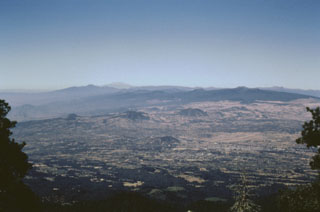Global Volcanism Program | Image GVP-08106

Xitle scoria cone, seen here in an aerial view from the NE with Ajusco volcano in the background, is one of the youngest cones of the Chichinautzin volcanic field. It is about 100 m high, with a crater that is 350 m wide and 115 m deep, and it formed around 2,000 years ago. Xitle (also known as Xicti) means “belly button” in the Nahuatl language, a reference to the shape of the cone and its crater. Volcán Ajusco is a Pliocene-Pleistocene lava dome complex surrounded by block-and-ash flow deposits.
Photo by Hugo Delgado, 1995 (Universidad Nacional Autónoma de México).
![]() This image is made available under the Creative Commons BY-NC 4.0 license terms.
This image is made available under the Creative Commons BY-NC 4.0 license terms.
Keywords: crater | scoria cone

Chichinautzin
